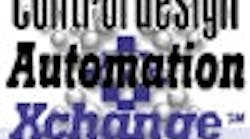By the time I got to Phoenix, preparations were complete for the May 2007 edition of Control Design’s AutomationXchange (CDAX). This event, now in its third year, puts well-matched automation buyers and sellers together for one-on-one meetings to discuss partnership opportunities between their two companies.
The machine builders have very particular automation needs, and the vendors have what looks to be a solution—that is, if we’ve all done our homework well.
As always, it is a very full and enlightening two-and-a-half days.
I had the opportunity to escort a gentleman from the semiconductor OEM segment. His manufacturing is offshore, but his engineering office is in the northern Midwest, and he lives on the East Coast.
The technology needs he came to AX looking to satisfy were varied. Some things he knew he needed. Some others he found he could use because his current solution was OK, but not as good. One of the solutions just “came up”—a system designed to lift parts without touching them. With semiconductor substrates, this can be very important. I was fascinated by his explanation of the process and why this was a good find.
I enjoyed his insight and candidness. “You can’t get this at a trade show,” he realized. He was referring to the impact the vendors he’d met at AutomationXchange had on his concepts of his machine control. He also was referring to the time available to confer with attending colleagues from different market sectors.
Because of his geographical location in Canada, he needs good technical support. His experience tells him he would be calling tech support only if he or his staff couldn’t solve the problem themselves, so the person on the other end of the phone … hmm, hold it—the phone?
The Internet has become so pervasive by now that all troubleshooting and technical support should happen there, right?
He dares to disagree. His argument is that if tech support is needed, then he’s exhausted all options. The crux of his serious problems won’t be garden-variety issues. So, he says, “The solution to my problems probably won’t be on a web site. I want someone to talk to.” And not just anyone, either.
This is all about relationships. If he’s in his manufacturing facility and needs help, he wants to talk to “Expert Bill.” He wants to be sure Bill understands his processes, and he knows him well enough to understand that he wouldn’t be calling Bill unless it’s important.
When I worked for Allen-Bradley, I prided myself on knowing my clients, and knew that when one of them called, it was a big deal. The early days of using PLCs caused a lot of that to happen.
Do all machine builders need the same level of service? Perhaps not, but if they had it, I think they’d consider it a competitive advantage.
We talked about the state of manufacturing and its effect on the ability to succeed. Another topic of our conversation was his strong interest in Ethernet-based intelligence. However, despite Ethernet’s many potential benefits, using it might be a problem for his company’s culture—another reminder that we still have a lot to learn.
Lethargy in any company’s culture takes the wind out of its sails. An environment of “lack-o-innovation” enables the thinking that “we’re OK if we just look after our legacy. If it ain’t broke, don’t fix it.”
It seems like too much of the country is suffering from this tunnel vision. I wonder whose fault it is. What do you think?
Next month I’ll tell you what I learned from my vendor meetings at AX. We never stop learning.
On a personal note, if you have a moment browse over to www.oryanproject.org. This is the web site of a non-profit foundation my wife and I are involved in to raise money, raise awareness, and ultimately help find a cure for cystic fibrosis. I’d be pleased to tell you more about it.
Jeremy has been involved in control system programming and training for more than 25 years, and he’s been writing about technology and software issues for many of those years. He can be reached at [email protected]




